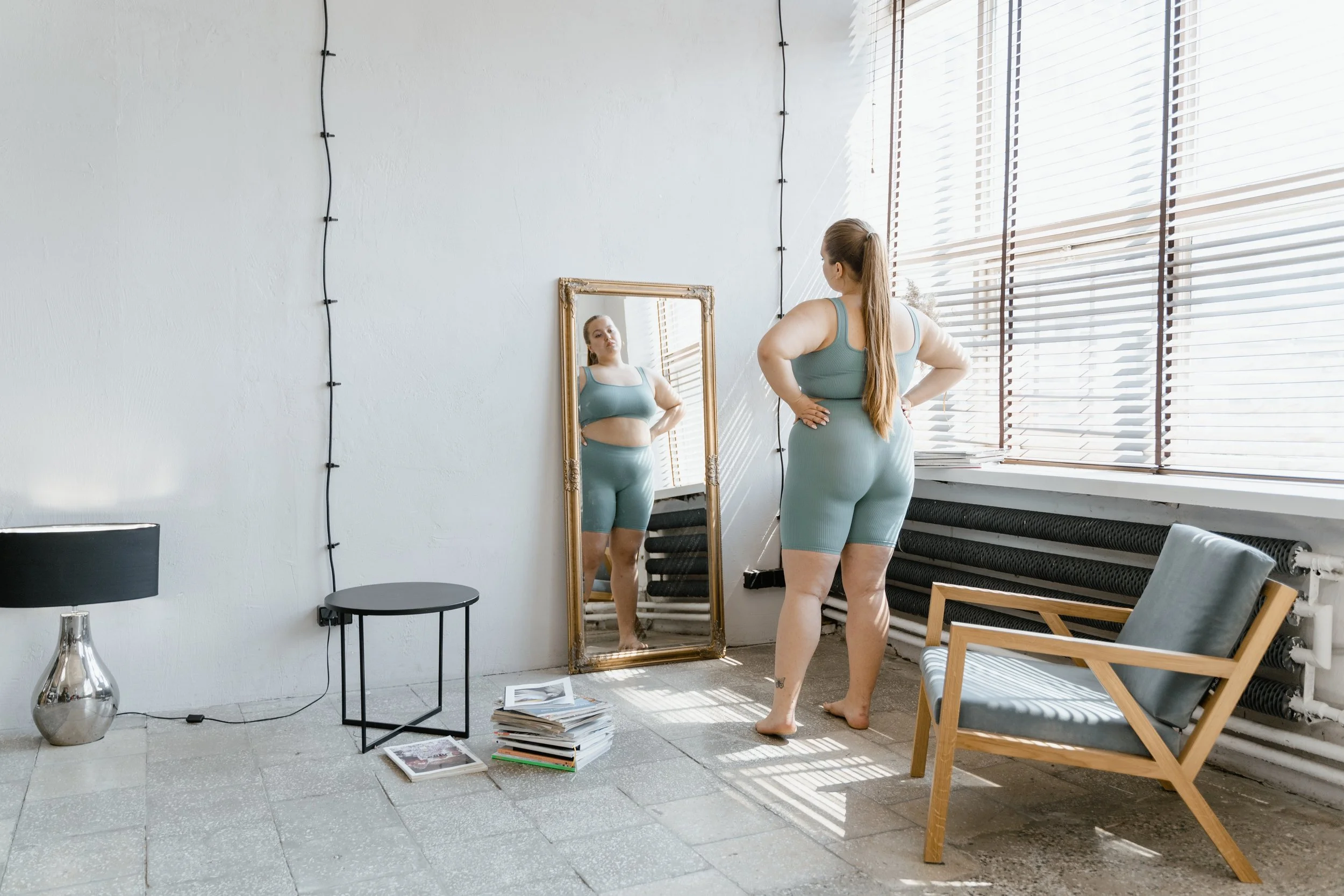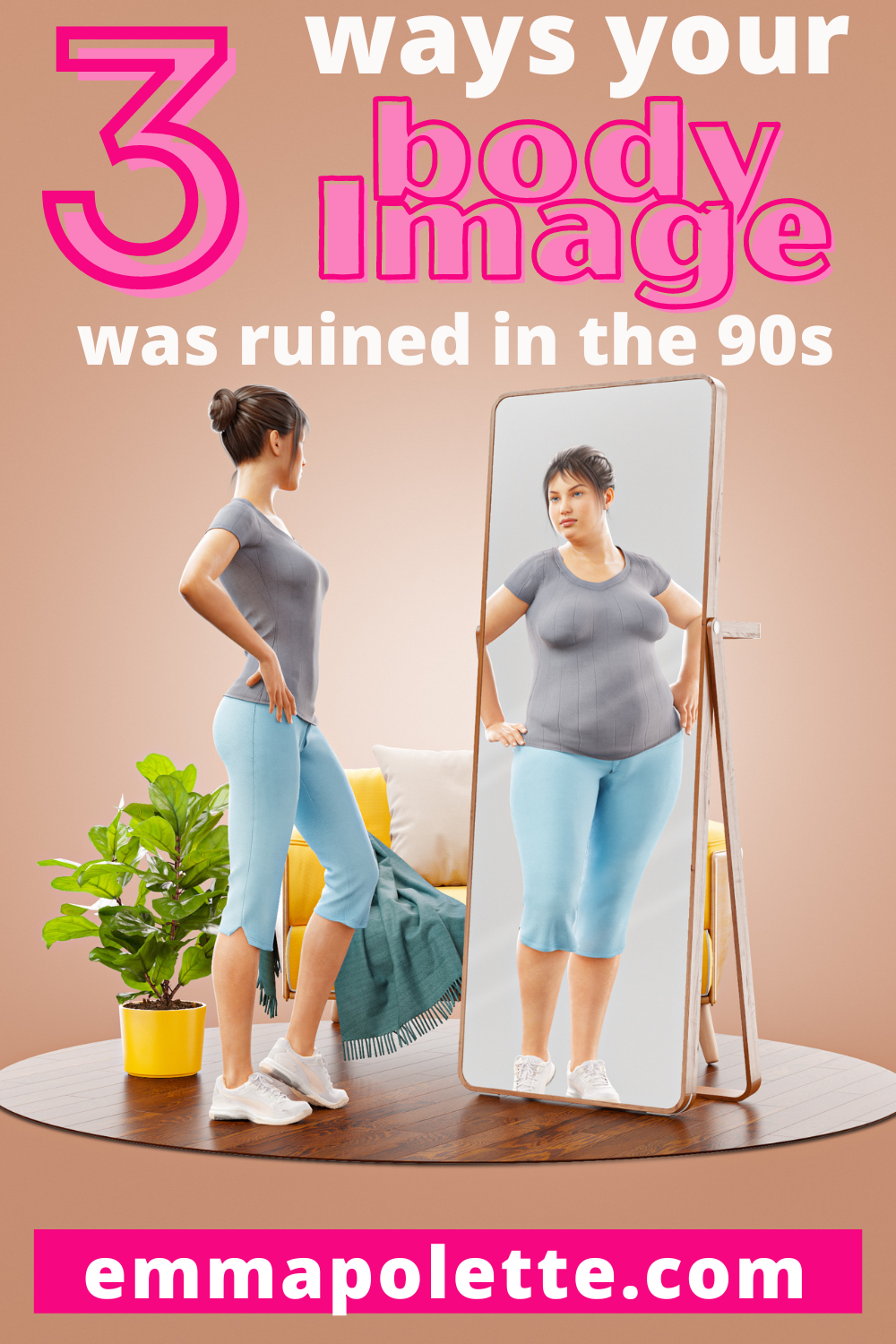3 ways your body image was ruined by diet culture in the 1990s & 2000s
I graduated from high school in 1990. My classmates and I thought we were so cool being the first group of kids to graduate in the NINETIES!! But we didn’t know that our late teens and twenties were going to be hijacked by diet culture, ruin our body image, and affect our self-esteem for years ahead.
So, if you’ve forgotten what it was like in the 90’s & ‘00s, check this out:
“Jumbo” Jessica
Bridget Jones calls herself “fat and alone”
“Fat” Monica was a source of ridicule in Friends.
These images reinforced the idea that being fat was bad (which in itself is wrong - see the bad science section below) and these people were not even particularly large.
So let’s break down what diet culture is, how it affects body image and how a bad body image can affect your entire life (and I’m not exaggerating).
What is diet culture?
According to Butterfly, the Australian charity that supports people with eating disorders,
“diet culture refers to a set of ever-changing myths about food and bodies, promoting the idea that one’s body weight automatically equals health and that foods can be simplistically categorised as ‘good’ and ‘bad’. It also comprises a moral hierarchy of bodies that preferences the thin-ideal while masking a fear of fat.
These cultural ideas are driven by broad systems and structures of power, such as patriarchal ideals about women’s bodies, racialised ideals around thinness and health, and capitalist industries that profit from body dissatisfaction and confusion around food and eating.”
Perhaps even more frightening is the fact that it is EVERYWHERE and we aren’t aware of it. I’ve heard of diet culture being likened to the water that a fish swims in. It’s there always and impacts our lives but we don’t see it unless we know to look for it.
How does diet culture affect body image?
Diet culture impacts body image in two main ways.
Firstly it makes people believe that being thin is the only way to be attractive/healthy. So anyone who doesn’t live in a thin body feels like there is something wrong with them and they must change their body in any way possible. This can lead to an obsession with food, exercise, and the number on the scale. For people who are caught up in this obsession, it may be hard to believe that most people aren’t obsessing with these things all day every day. They may find it hard to maintain relationships, have hobbies that don’t involve food or exercise, or they may lack the energy to get through their day. The worst outcome is that the obsession leads to an eating disorder which is a collection of mental illnesses with the highest mortality rates.
The second major impact of diet culture is the rampant fatphobia it creates. Even if you aren’t obsessed with being thin, you are probably terrified of being fat. That’s because diet culture makes us believe that being fat means you are automatically unhealthy, lazy, and unattractive. But here’s the thing, you can’t tell how healthy someone is by looking at them!
For people who live in larger bodies life is made much more difficult because of fatphobia. They can find it hard to find chairs that they can sit in comfortably. They are often overlooked for jobs and earn less than thin people. They often can’t find clothes that fit. They are told to lose weight by health professionals rather than being listened to and believed when they have health issues. They are trolled by strangers online and told that they “glorify obesity.”
It is not easy to live in a fat body in this world and that’s all down to diet culture. It feels like it’s the last thing that is socially acceptable to discriminate against people for. No wonder we are all so fearful of putting on weight! But here’s the truth. Even if we all ate and exercised in exactly the same way there will always be thin and fat people. People in larger bodies are humans that deserve happiness and dignity just like everyone does.
Why is body image important?
A 2016 study by Dove determined that “a staggering 89 percent of Australian women are opting to cancel plans, job interviews, or other important engagements simply because of how they look.” This shows that when we don’t like how we look, we aren’t living life to the fullest! We are holding ourselves back because of a tummy roll. This makes me so sad!
An unsatisfactory body image can also lead to self-objectification which means a person spends more time focused on their outward appearance rather than how they feel on the inside. This affects cognitive function, interoceptive awareness, and more. Check out the article I wrote about self-objectification for more info.
To put it in a nutshell, bad body image affects self-confidence, the ability to think straight, our perceptions of our bodily sensations and emotions, and most importantly our mental health. It’s definitely not a small issue!
So, what happened in the 90’s?
The ’90s & early ’00s were a unique time where fashion, a plethora of diet books, and an astounding amount of bad science were mixed together to create what is arguably the most toxic period in diet culture history.
Heroin Chic (and it’s making a comeback!)
This was the time when skinny was hot. Kate Moss was the it-girl of the late ‘90s and she famously said, “Nothing tastes as good as skinny feels.” This, said by someone who has also said that she is naturally thin and doesn’t need to diet, set off a generation of women who felt restriction was the only way to get the body of the time.
The fashion of this time was also very skinny-centric, focused on extreme low-rise jeans and skirts that just barely covered butt cheeks. I don’t say this to shame anyone for wearing clothes that are skin-baring. The problem with the ’90s and ‘00s was that it was only acceptable to wear these clothes if you were thin.
The tabloid magazines at the time would shame celebrities for not bouncing back from having a baby or praise someone for losing the last 5 kilos. We were surrounded by the message that being thin is the only way to be attractive, and whatever you do, don’t get fat(ter) because that will result in shame and ridicule.
The sad thing is that even though we know better now (I thought?), this ultra-thin look is coming back into fashion along with ultra-low-rise pants. Hopefully, since we lived through it the first time, we won’t fall for it again (especially after you read the next bit of this blog post!).
2. Fad diets (which are now called lifestyle changes, but they are the same thing!)
I recently asked my Instagram followers what the worst diet culture thing from the ‘90s was and the most common answer was “doing weekly weigh-ins with my mum”. I can’t say this for sure, but to me, it implies a Weight Watchers membership. I can’t say I blame the mums because they were living in a world that revered thin people (see section above) and they were backed up by “science” (see the section below).
Besides Weight Watchers, some of the other popular diets of the 90s and 2000s were The Atkins diet, The Zone, The Blood Group Diet, and anything low fat or no fat. I remember my dad always cutting off every skerrick of fat from his meat before he would eat it, and he still died of a heart attack in a slim body at age 54, which just shows you that we can’t control what happens to us through our diets, but that’s a whole other blog post.
Diets were so ubiquitous, you felt wrong if you WEREN’T on one. For many of us, this is where our distrust of our own hunger/fullness signal and war with food was born.
3. Bad Science and the BMI (it’s still happening)
If you asked a doctor if they would prescribe a drug for cholesterol (or any medical issue) that helped for a short time but would ultimately make the problem worse, the answer would be no. But, unfortunately, doctors are doing this every day when they ask their patients to lose weight.
There is not one long-term study that shows that deliberate weight loss attempts are successful for more than 90% of the population. The typical trajectory for weight loss (and gain) is this: lose weight initially, start to put it back on within 12 months, regain the entire amount by the 5-year mark, and for two-thirds of the population, gain even more weight than you lost. In fact, a 2007 study by Mann et al showed that dieting is the best PREDICTOR OF WEIGHT GAIN. So if you want to GAIN weight, go on a diet.
But if you lived in the 90s you are probably still holding onto the oversimplified science of “move more, eat less” to lose weight, and unfortunately, that approach will derail your efforts every time.
Here’s the other terrible science decision for the 1990s… In 1998 the National Institutes of Health in the US changed the definitions of overweight and obese in relation to BMI. This meant that literally overnight millions of people moved from being in the “normal” range to “overweight” and “overweight” to “obese” without gaining a single gram of weight. The goalposts had changed and the decision was heavily dictated by pharmaceutical companies that sell (you guessed it) weight loss drugs. I’ve used quotation marks around the BMI descriptors of weight because the BMI is a terrible tool to determine individual health and you can read more about it by reading this article.
What we also know now is that you can’t determine someone’s health by the number on the scale or by how they look. Healthy behaviours dictate health, and weight is not a behaviour. People carry weight for all sorts of reasons (genetics, medications, stress, aging, etc.) so judging a book by its cover is not applicable to humans either!
So you can see that a confluence of factors including what was fashionable and deemed attractive, the cultural excitement and bonding over fad diets, and terrible public health advice based on flawed science came together to start a war on bodies and impact our individual feelings towards our body image. This has created a generation of women who are afraid to be anything but slim, and who will often hold themselves back from life engaging activities if they don’t fit the thin-ideal. It has led to the prevalence of diets and a global industry worth over $200 billion. And that doesn’t factor in the amount of energy, brain space, and self-esteem lost to bad body image.
What to do now?
First of all, forgive yourself for treating yourself so badly over the last 30 years! You have been swimming in the waters of diet culture for a very long time and you didn’t even know it. Your parents, your favourite TV shows, your friends, and the glossy mags of the ’90s and ‘00s made you believe that you had to be thin to be desirable and healthy.
Take some time to grieve the body you thought might be possible if you just tried hard enough. Grieve the amount of time, money, and brain space you’ve wasted on these (always) unattainable dreams.
And then decide to get angry for a bit. Decide to give up self-objectification. Learn that you are worthy, amazing, and special just as you are, even if you don’t look the way you’ve always wanted to. Change the mindset of thin = healthy and attractive. Start following all sizes and ages on social media. Question the things you read about health in popular media and start reading peer-reviewed articles instead.
And finally, start treating your body with respect. Exercise because you can, and it feels good rather than focusing on calories burned. Relearn to honour your body’s hunger and fullness and feed it foods that are delicious, nutritious, and satisfying knowing that you can trust your body to steer you in the direction of being healthy enough. And give up the constant need for perfection. You are wonderful as you are and perfection is not necessary.
If you would like to delve deeper into all of this and start to heal your relationship with your body then get in touch. I have a 6-week private coaching program where I provide a safe and supportive space to unpack your body image and help you create a fail-proof health & well-being plan to support you physically and mentally. This personalised program is $395. Click here to book a free, no-obligation 15-minute chat to see if it’s for you.
Other posts about body image that you’ll love
Reflections on a year of self-care
My before & after photos and how my body image improved after I gained weight





